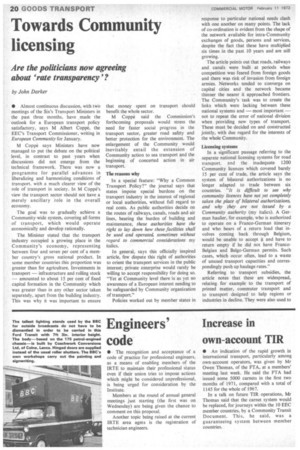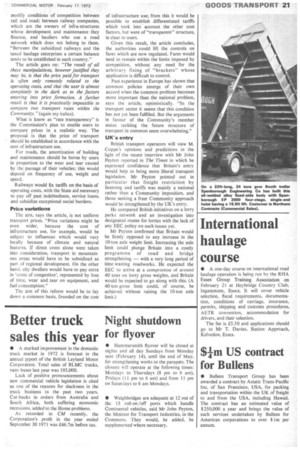Towards Community licensing
Page 22

Page 23

If you've noticed an error in this article please click here to report it so we can fix it.
Are the politicians now agreeing about 'rate transparency'?
by John Darker
• Almost continuous discussion, with two meetings of the Six's Transport Ministers in the past three months, have made the outlook for a European transport policy satisfactory, says M Albert Copt* the EEC's Transport Commissioner, writing in European Community for January.
M Coppe says Ministers have now managed to put the debate on the political level, in contrast to past years when discussions did not emerge from the technical framework. There was now a programme for parallel advances in liberalizing and harmonizing conditions of transport. with a much clearer view of the role of transport in society. In M Coppe's view the transport sector should not have a merely ancillary role in the overall economy.
The goal was to gradually achieve a Community-wide system, covering all forms of transport, which would operate economically and develop rationally.
The Minister stated that the transport industry occupied a growing place in the Community's economy, representing between four and seven per cent of a member country's gross national product. In some member countries this proportion was greater than for agriculture. Investments in transport — infrastructure and rolling stock — amounted to about 15 per cent of fixed capital formation in the Community which was greater than in any other sector taken separately, apart from the building industry. This was why it was important to ensure that money spent on transport should benefit the whole sector.
M Cook said the Commission's forthcoming proposals would stress the need for faster social progress in the transport sector, greater road safety and better protection for the environment. The enlargement of the Community would inevitably entail the extension of Community action to sea transport and the beginning of concerted action in air tran sport.
The reasons why In a special feature: "Why a Common Transport Policy?" the journal says that states impose special burdens on the transport industry in the interest of regional or local authorities, without full regard to real costs. As public authorities decide on the routes of railways, canals, roads and air lines, bearing the burden of building and maintenance, these authorities have the right to lay down how these facilities shall be used and operate4 sometimes without regard to commercial considerations my italics.
In general, says this officially inspired article, few dispute this right of authorities to orient the transport services in the public interest; private enterprise would rarely be willing to accept responsibility for doing so. "Yet at Community level there is as yet no awareness of a European interest needing to be safeguarded by Community organization of transport."
Policies worked out by member states in response to particular national needs clash with one another on many points. The lack of co-ordination is evident from the shape of the network available for intra-Community exchanges of goods, persons and services, despite the fact that these have multiplied six times in the past 10 years and are still growing.
The article points out that roads, railways and canals were built at periods when competition was feared from foreign goods and there was risk of invasion from foreign armies. Networks tended to converge on capital cities and the network became thinner the nearer it approached frontiers. The Community's task was to create the links which were lacking between these national systems and — most important — not to repeat the error of national division when providing new types of transport. These must be decided on and constructed jointly, with due regard for the interests of the whole Community.
Licensing systems In a significant passage referring to the separate national licensing systems for road transport. and the inadequate 1200 Community licences which covered barely 15 per cent of trade, the article says the system of bilateral authorizations is no longer adapted to trade between six countries. "It is difficult to see why community licences have not yet completely taken the place of bilateral authorizations, and why they are not issued by a Community authority (my italics). A German haulier, for example, who is authorized to operate on a Franco-German itinerary and who hears of a return load that involves coming back through Belgium, would be unable to accept kt and have to return empty if he did not have FrancoBelgian and Belgo-German permits. Such cases, which occur often, lead to a waste of unused transport capacities and correspondingly push up haulage rates."
Referring to transport subsidies, the article notes that these are widespread, relating for example to the transport of printed matter, commuter transport and to transport designed to help regions or industries in decline. They were also used to modify conditions of competition between rail and road; between railway companies, which are the owners of infra-structures whose development and maintenance they finance, and hauliers who use a road network which does not belong to them. "Between the subsidized railways and the taxed haulage enterprises a certain balance tends to be established in each country."
The article goes on: "The result of all these manipulations, however justified they may be, is that the price paid for transport is often only remotely related to the operating costs, and that the user is almost completely in the dark as to the factors entering into price formation. A further result is that it is practically impossible to compare two transport rates within the Community. "(again my italics).
What is know as "rate transparency" is the Commission's plan to enable users to compare prices in a realistic way. The proposal is that the price of transport should be established in accordance with the cost of infrastructure use.
For roads, the amortization of building and maintenance should be borne by users in proportion to the wear and tear caused by the passage of their vehicles; this would depend on frequency of use, weight and speed.
Railways would fix tariffs on the basis of operating costs, with the State aid necessary to pay off past indebtedness, service loans, and subsidize exceptional social burdens.
Price variations The aim, says the article, is not uniform transport prices. "Price variations might be even wider, because the cost of infrastructure use, for example, would be subject to influences which would vary locally because of climate and natural features. If direct costs alone were taken into consideration, transport in mountainous areas would have to be subsidized as part of regional development. On the other hand, city dwellers would have to pay extra in 'costs of congestion', represented by loss of time, wear and .tear on equipment, and fuel consumption."
The aim of this reform would be to lay down a common basis, founded on the cost of infrastructure use; from this it would be possible to establish differentiated tariffs which took into account the other cost factors, hut were of "transparent" structure, ie clear to users.
Given this result, the article concludes, the authorities could lift the controls on fares which are now regulated.. Fares would tend to remain within the limits imposed by competition, without any need for the arbitrary fixing of "brackets" whose application is difficult to control.
Past experience in Europe has shown that common policies emerge of their own accord when the common problem becomes more important than the national problem, says the article, optimistically. "In the transport sector it seems that this condition has _not yet been fulfilled. But the arguments in favour of the Community's member states tackling the future structure of transport in common seem overwhelming."
UK's entry • British transport operators will view M. Coppe's opinions and predictions in the light of the recent interview with Mr John Peyton reported in The Times in which he expressed confidence that Britain's entry would help to bring more liberal transport legislation. Mr Peyton pointed out in particular that freight restriction by licensing and tariffs was mainly a national rather than a Community imposition, and those seeking a freer Community approach would be strengthened by the UK's entry.
He compared British initiatives on a lorry parks network and an investigation into designated routes for lorries with the lack of any EEC policy on such issues yet.
Mr Peyton confirmed that Britain would be firmly opposed to any increase in the 10-ton axle weight limit. Increasing the axle limit could plunge Britain into a costly programme of road and bridge strengthening — with a very long period of time-wasting roadworks. He expected the EEC to arrive at a compromise of around 40 tons on lorry gross weights, and Britain would be expected to go along with this. (A 40-ton-gross limit could, of course, be achieved without raising the 10-ton axle








































































































